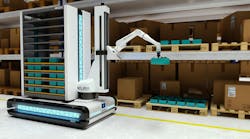You'd think there’d be a lot more robots by now.
There are about 1.5 million robots in service right now, which to put into perspective, was about how many people gathered outside my office window in Downtown Cleveland to celebrate the Cavaliers' first championship -- and the city's first since 1964, which is three years after the first robot, Unimate made its debut . So that’s a long time, and not a lot of robots.
Unimate debuted in 1961, but industrial robots still know relatively little about love or world domination.
But the times they are a changin'. The International Federation of Robotics reports that industrial robot sales will increase 15% annually until 2018.
This means factories and plants will employ about 2.3 million industrial robots globally. As this robot worker population rises, the manufacturers and operators will want to see their profit margins increase as well.
This means the new breed of bots will change, becoming even more efficient and productive, says Lucas Kehl, a product manager at Lapp Group with a background in mechatronics.
Lapp specializes in cables and connectors, and Kehl believes that changes in the construction and installation of these can help robot manufacturers achieve their goals by making robots more safe and get more done. Here are the four top trends he’s identified and how cables advancements will help.
Dropping Weight
Unimate weighed 2 tons and its job was to pick up die castings and welded them into car frames. Yaskawa's 6-axis Motoman-MH24 weighs just shy of 600 lb. and can assemble, package and handle materials – oh, and bring shame to world-class samurais.
"You could move robot along with the piece so you don’t lose any more time waiting for the process to be done," Kehl says. "You move the good and robot forward together."
Mobile robotics also help production teams delegate resources and optimize production to prevent wasting valuable time.
"If you see further demand or a bottleneck, move and transfer robots from another line that isn’t fully loaded to help out," Kehl says.
When you have robots rolling around the plant floor, external wiring becomes untenable. Think about the last time you vacuumed and how many times you tripped over the cord. Now put those cords at neck level and attach them to a whirling, rotating metal arm. Bad things would happen.
"It can be very important that all wiring is internal, and only the arm is moving around," Kehl says.
Internal cabling is also key for fixed robots working in close proximity. Sometimes 15 to 18 welding robots could be assembling a car chassis at the same time, often at breakneck speeds. Running the cables on the inside saves space, prevents tangling, and keeps the cables from coming loose.
Internal cables aren’t always the right move for all robots, though.
"With external cables, you just install and put conduit around it," the product manager says. With internal cables, there’s more stress because the bending radius is tighter, and there are reliability issues because of the maintenance. They can’t be replaced as easily."
Cable Bundling
Remember before smart TVs when you wanted to listen to music or watch a movie or show you’d have to switch the mode on your TV, turn on your cable box, VCR or Laserdisc, and then turn on your receiver to blast your totally boss surround sound?
Yeah, achieving the’90s "home theater" experience was ridiculously complicated, and the bundle of tangled wires behind your entertainment center collected dust and swallowed any pen or set of keys you had the misfortune of dropping down there.
"I can't find my phone charger. Someone call IT."
And even tidy, tie-wrapped bundles of wires take up a lot of space.
Now imagine if your old school entertainment system had a 24/7 job where it had to spin and slide around, move things from one shelf to another and whatnot, you could see where having all these wires would be a problem.
That’s the issue robots face. And as more connections are added, such as cables to carry machine vision signals, the problem grows.
For your home theater, this would be just a minor inconvenience. For industrial robots, which are constantly accelerating and exerting force on the cables, affecting precision, flexibility, and equipment lifespan, the problem is more significant.
The answer is hybrid cables.
"In one cable, you can transmit power, feed the motor and have some control and signal conductors," Kehl says. "We can strand everything you want in one cable which fulfills different applications."
The space saving construction on hybrid cables, such as Lapp’s ÖLFLEX SERVO FD 7DSL, which along with supplying power and transmitting data, could also house media lines for oil or compressed air.
No two robot applications or environments are alike, so Kehl says Lapp only has four standard robot cables, but constantly makes customized ones for individual customers.
The Force Field
There are some robots like Rethink Robotics' Sawyer, who can daintily pick and pack lightbulbs, and do it with a smile on their face (or screen). Others look like giant scorpion tails, spitting out metal-melting flames, moving with intense speed and purpose.
Because of this, the cables used for automotive and high velocity applications need to be made of a tougher stuff. Kehl recommends using an advanced cable designed to handle millions of bending cycles and high torsion.
One option is Lapp’s ÖLFLEX ROBOT F1, a TPE-PUR robot cable designed for simultaneous flexing and torsion loads in multi-axis articulated robots and automated handling equipment.
Some robot cables implement a special alloy to withstand 300 N/mm² (a standard withstands 20 N/mm²).
The other part is using longer lay lengths than continuous flex cables, which compensates for stressful torsional forces.
Whatever your torsion application is, Kehl recommends considering the following parameters:
- Maximum speed and acceleration
- Minimum bending radii of cables and wires
- Combined weight of all moving components (including the carrier track and related cables)
- Desired life expectancy of the complete system.
For more information on robotic cable applications, read Kehl’s white paper, "The Next Generation of Advanced Robotics."













